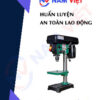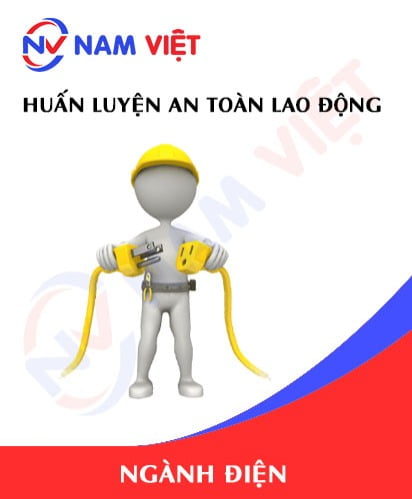Occupational Safety Training for Operating Wall Grooving Machines
99,000 ₫
Note: The price above is calculated per person and may fluctuate depending on the number of participants in the course and market conditions. For more accurate pricing support, please refer to the price list or contact our consulting staff directly.
Occupational safety is an important issue when operating a wall chaser and must be addressed promptly to ensure the health and safety of workers and enhance the reputation of businesses here. The Occupational Safety Training course is one of the effective solutions to raise awareness of how to prevent workplace accidents for workers operating a wall chaser.
Table of Contents
Toggle1. Overview of Wall Groove Cutting Machines
a. What is a Wall Groove Cutting Machine?
A wall groove cutting machine, also known as a concrete groove cutting machine, is a type of equipment used to create grooves or cuts on the surface of walls or concrete surfaces. This machine is commonly used in the construction industry to cut grooves for installing water pipes, electrical conduits, or cables, or to create grooves for installing piping and wiring systems. Wall groove cutting machines can come in various sizes and types, from small handheld machines for compact jobs to large machines used in bigger construction projects.
Grooving walls before installing piping and wiring systems can save time and effort in the deployment and maintenance of the systems later. Wall groove cutting machines are usually equipped with powerful cutting blades to efficiently cut through concrete and other building materials.

b. Operating Principle of Wall Groove Cutting Machines
The operating principle of a wall groove cutting machine usually involves using a cutting blade to remove material from the surface of a wall or concrete. Here are some basic principles of how a wall groove cutting machine works:
- Cutting Blade: The machine is equipped with one or more sharp cutting blades, often diamond blades or alloy blades. These blades spin at high speeds to cut through the wall or concrete surface.
- Motor: The machine has a powerful motor to provide the necessary force to rotate the cutting blade and cut through materials. The motor is typically powered by electricity or gasoline.
- Depth and Width Control: Operators can adjust the depth and width of the grooves using the control mechanisms on the machine. This allows them to create grooves of specific sizes and shapes.
- Water Cooling: The machine is often equipped with a water cooling system to reduce the temperature of the cutting blade and prevent overheating. Water also helps smooth the groove surface and remove dust and concrete debris.
- Safety: Safety is crucial when using the machine. Operators should wear safety glasses, masks, and ear protection to guard against dust and noise. Additionally, they should follow safety rules and the manufacturer’s instructions.

c. Industries Using Wall Groove Cutting Machines
Wall groove cutting machines are used in many different manufacturing and construction industries. Here are some main industries that use these machines:
- Construction Industry: Wall groove cutting machines are essential tools in construction. They are used to cut grooves on concrete surfaces and walls for installing water pipes, electrical conduits, cables, and other piping systems. They are also used to create necessary grooves during renovation and repair projects.
- Electronics Industry: In electronics manufacturing, wall groove cutting machines can be used to cut and process flexible materials like plastic and rubber to create specific components.
- Wood Industry: In furniture and wood product manufacturing, the machine can be used to cut and process wood panels or other wood materials to create specific parts.
- Metal Manufacturing: The machine can be used to cut and process metal to create parts or metal structures needed in production.
- Stone and Marble Industry: In stone extraction and processing, wall groove cutting machines can be used to cut and shape stone and marble into specific sizes and forms.
2. Overview of Safety Training for Operating Wall Groove Cutting Machines
a. What is Occupational Safety Training?
- Occupational safety training for operating wall groove cutting machines provides workers with awareness on preventing workplace accidents. Workers directly working with wall groove cutting machines are considered Group 3.
- The safety training course helps workers recognize and avoid hazards, reducing the risks of workplace accidents while performing tasks.
REGISTER FOR OCCUPATIONAL SAFETY TRAINING SERVICE
b. Training Duration
Initial Safety Training Duration
- Total training time is at least 24 hours, including examination time.
- 8 hours of theoretical lessons on policies, laws, and occupational safety regulations
- 8 hours of theoretical lessons on basic occupational safety knowledge
- 4 hours of theoretical lessons on specialized training content
- 2 hours of practical training on specialized content
- 2 hours of final theoretical examination
The training center will schedule sessions depending on worker availability. Typically, there are 6 training sessions over 3 days, provided the company can allocate continuous study time.
Periodic Safety Training Duration
- Before the occupational safety card expires, workers who wish to renew it must undergo periodic safety training, with training time of at least 50% of the initial training duration.
Explanation: The total duration of periodic occupational safety training is at least 12 hours, including examination time. After completing the periodic training and passing the test, workers will receive a renewed safety card.
c. Training Course Content
| No. | TRAINING CONTENT | TRAINING TIME (HOURS) | |||
| Total | Including | ||||
| Theory | Practical | Exam | |||
| I | Policies, laws, and occupational safety regulations | 8 | 8 | 0 | 0 |
| 1 | Overview of laws and regulations on occupational safety and hygiene. | 6 | 6 | ||
| 2 | Standards and technical regulations on occupational safety and hygiene. | 1 | 1 | ||
| 3 | Specific regulations of state management agencies on occupational safety and hygiene when constructing, expanding, or renovating facilities, including machinery, equipment, materials, and substances with strict safety requirements. | 1 | 1 | ||
| II | Basic knowledge of occupational safety | 8 | 8 | 0 | 0 |
| 1 | Basic knowledge of hazardous factors in the workplace. | 4 | 4 | ||
| 2 | Methods to improve working conditions. | 1 | 1 | ||
| 3 | Safety culture in production and business. | 1 | 1 | ||
| 4 | Rights and obligations of employers and workers; policies on occupational safety; roles of safety networks and officers. | 1 | 1 | ||
| 5 | Safety regulations, signage, and use of safety equipment and personal protective equipment; first aid and occupational disease prevention skills. | 1 | 1 | ||
| III | Specialized training content | 6 | 4 | 2 | 0 |
| Comprehensive knowledge of machines, equipment, hazardous materials; risk analysis, management of occupational safety, and safe operating procedures with equipment and materials requiring strict safety standards. | 6 | 4 | 2 | ||
| IV | Final examination of safety training content | 2 | 2 | 0 | 0 |
| Total | 24 | 22 | 2 | ||
See more training content of the 6 groups
d. Occupational Safety Card
After completing the safety training course and passing the examination, workers will be issued an occupational safety card (commonly known as a Group 3 safety certificate).
The Group 3 safety card clearly shows the worker’s name, date of birth, specific job and work environment, training duration, red seal, and signature confirming course completion.
According to regulations in Clause 2 of Article 24 of Decree 44/2016/ND-CP, there are 2 cases:
- If the employer and worker have an employment contract, the employer must sign and stamp the safety card after the worker completes the Group 3 training from a certified training unit and passes the exam.
- If the worker is freelance or seasonal without an employment contract, the training unit must sign and stamp the safety card after the worker completes the training and passes the exam.

3. Hazards When Operating Wall Groove Cutting Machines
Operating a wall groove cutting machine can involve many hazards and risks, especially if safety rules are not followed. Here are some common hazards when operating a wall groove cutting machine:
- Injuries from the cutting blade: The machine’s blade can cause injuries if not used properly or if the machine gets jammed. Operators should ensure they are using the correct blade for the material being cut and follow the instructions for safe cutting.
- Dust and wood or concrete particles: The cutting process produces dust and material particles, which can cause respiratory issues. Operators should wear protective masks and goggles to protect against dust and particles.
- Noise: Wall groove cutting machines generate high noise levels, which can harm hearing. Operators should use ear protection or earplugs.
- Electrical hazards: If the wall groove cutter is electrically powered, working near water or in wet conditions can create electrical hazards. Follow electrical safety guidelines and ensure the machine is used in safe conditions.
- Machine jamming: If the machine jams during cutting, it can cause injuries and damage the machine. Operators should know how to handle such situations and turn off the machine when necessary to avoid further risks.
- Wall or concrete collapse: Cutting grooves can destabilize walls or concrete, making them prone to collapse. Operators should assess the stability of the wall or surface and ensure proper support is in place.
- Fire or explosion: In some cases, cutting may create flammable conditions, especially if the material contains combustible dust. Follow safety rules regarding fire and explosion risks.

4. Occupational Accident Control Measures When Operating Wall Groove Cutting Machines
Controlling occupational accidents when operating wall groove cutting machines is crucial to ensure the safety of operators and people around them. Here are some necessary measures to ensure safe use of wall groove cutting machines:
- Training: Ensure that all operators are trained on the safe use of the machine. They need to know how to operate it, cut safely, and handle emergency situations.
- Use protective equipment: All operators should wear full personal protective equipment, such as goggles, masks, ear protection, gloves, dust-resistant jackets, and safety shoes.
- Check the machine before use: Before starting work, inspect the machine to ensure it is functioning properly, has no technical defects, and that the blade is sharp.
- Choose the correct blade: Ensure the blade is selected based on the material to be cut. Use diamond blades for concrete and hard materials, and alloy blades for other materials.
- Consider working conditions: Evaluate the work environment, including weather, humidity, and potential surface collapse. Do not work in unsafe conditions.
- Clean the work area: Remove dust and particles from the work area to reduce respiratory hazards and maintain a smooth, safe workspace.
- Perform regular maintenance: Maintain the wall groove cutting machine regularly to ensure proper operation. Frequently check the blade and cooling system.
- Be careful when cutting near electrical wires and pipes: Before cutting, ensure there are no hidden wires or pipes behind the wall. Operate the machine carefully to avoid damaging these systems.
- Use machines with safety systems: Some machines have safety features such as safety locks or automatic shutoff mechanisms. Ensure your machine has these features.
- In case of emergency, stop and turn off the machine immediately to prevent the situation from worsening.
- Periodically inspect the machine to detect safety issues such as wear or mechanical defects, reducing the risk of workplace accidents.
5. Benefits of Occupational Safety Training
An Toàn Nam Việt provides your business with the following benefits after completing occupational safety training courses in accordance with Decree 44/2016/ND-CP on Occupational Safety and Hygiene:
- Workers can identify potential hazards of workplace accidents and take preventive measures to avoid accidents.
- Your business can establish risk prevention measures in production, operation, and maintenance processes.
- Reduce costs related to safety risks in the workplace.
- Uninterrupted production helps increase labor productivity and product quality.
- Compliance with labor safety laws, reducing legal risks.
- Enhance credibility and professionalism, thereby elevating your business brand.
Nam Việt’s training courses are designed to prevent external hazards from affecting individuals, helping them avoid dangers that could cause injuries or even death.
REGISTER FOR OCCUPATIONAL SAFETY TRAINING SERVICES
6. Customer Feedback After Completing Training
An Toàn Nam Việt has years of experience supporting businesses across Vietnam, especially in the southern provinces. This responsibility is invaluable to Nam Việt, which is why our occupational safety training is increasingly professional. The motivation behind our growth comes from positive feedback and suggestions from our partners. Below are some testimonials from our clients.
See more customer interviews after using our services at An Toàn Nam Việt
7. Occupational Safety Training Capability of An Toàn Nam Việt
An Toàn Nam Việt is a reputable and high-quality occupational safety training center in Vietnam. Our safety training sessions are continuously conducted at production workshops, factories, or construction sites nationwide (all 63 provinces in Vietnam).
REGISTER FOR OCCUPATIONAL SAFETY TRAINING SERVICES
Occupational Safety Training License
- An Toàn Nam Việt has been inspected and certified by the Department of Safety under the Ministry of Labor – Invalids and Social Affairs as meeting the conditions to provide occupational safety and hygiene training. This further strengthens our training capabilities.

Training Materials and Lectures
- Before training materials are used in our occupational safety training courses, they are reviewed and approved to ensure accurate knowledge and practical effectiveness.
- Our instructors’ teaching methods are standardized according to An Toàn Nam Việt’s training methodology, which has been developed by experts in occupational safety and hygiene to maximize knowledge retention for trainees.
Facilities
- Controlling classroom factors affecting training improves teaching efficiency and knowledge retention.
- Our training facilities provide spacious classrooms with proper lighting and equipment for training sessions.
8. Nationwide Reputable Safety Training Center
At An Toàn Nam Việt, we prioritize professional occupational safety training. Our mission is to equip workers with knowledge to protect themselves, contributing to the development of the country.
To ensure effective training, we meticulously prepare every detail, from tools and teaching equipment to curricula, materials, audio, and lighting.
Our occupational safety instructors are experts with years of experience. They have conducted research to identify hazards across industries and teach effective prevention methods.
Lectures are practical, engaging, and easy for workers to understand. Knowledge is always aligned with Decree 44/2016/ND-CP.
This enables workers to learn hazard prevention and self-protection, applying it appropriately in real work scenarios.
Our safety training center proudly provides professional and reliable occupational safety training services with the following advantages:
- Competitive training costs while maintaining high quality.
- Flexible training schedule tailored to company production needs.
- Quick certification process following legal regulations.
- Experienced instructors with long-term expertise.
- Classroom control enhances teaching efficiency and knowledge retention.
- Lectures are designed specifically for occupational safety in enterprises.
- An Toàn Nam Việt provides dedicated, professional support for clients accurately and promptly.

9. Additional Occupational Safety Training Materials
- Occupational Safety Training Materials Set
- Occupational Safety Materials for Operating Wall Groove Cutting Machines
- Occupational Safety Training Test Set
- Occupational Safety Quiz for Wall Groove Cutting Machine Operation
- Slide Deck for Occupational Safety Training on Wall Groove Cutting Machine Operation
1 review for Occupational Safety Training for Operating Wall Grooving Machines
No comments yet















phanminhhang341
Giảng viên dạy rất sinh động dễ hiểu!